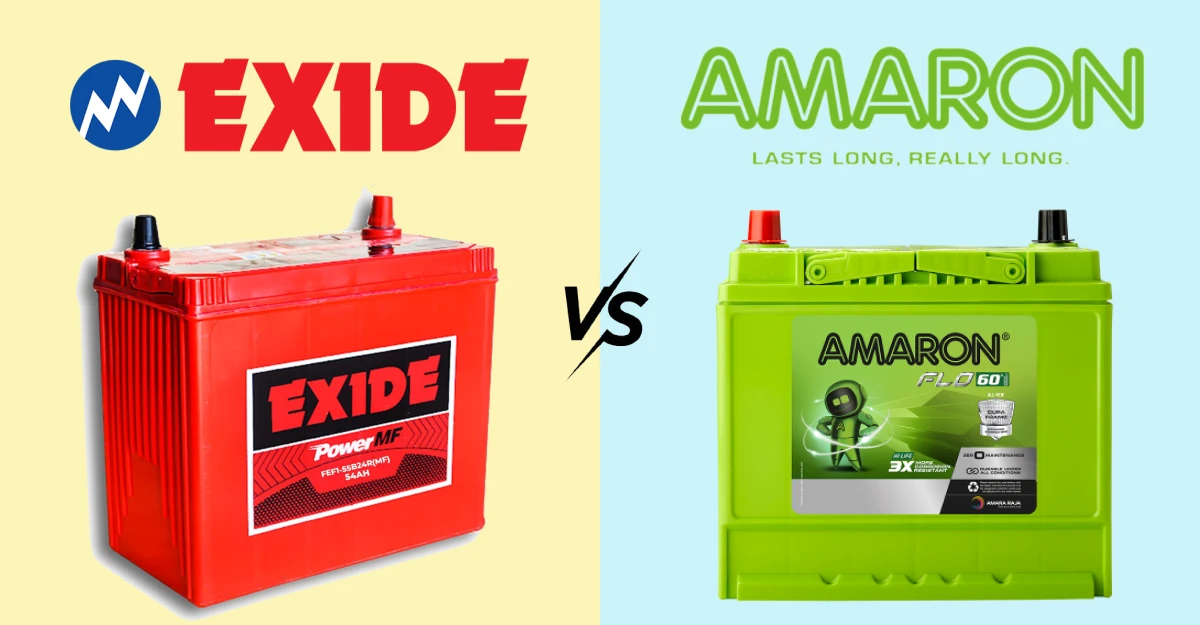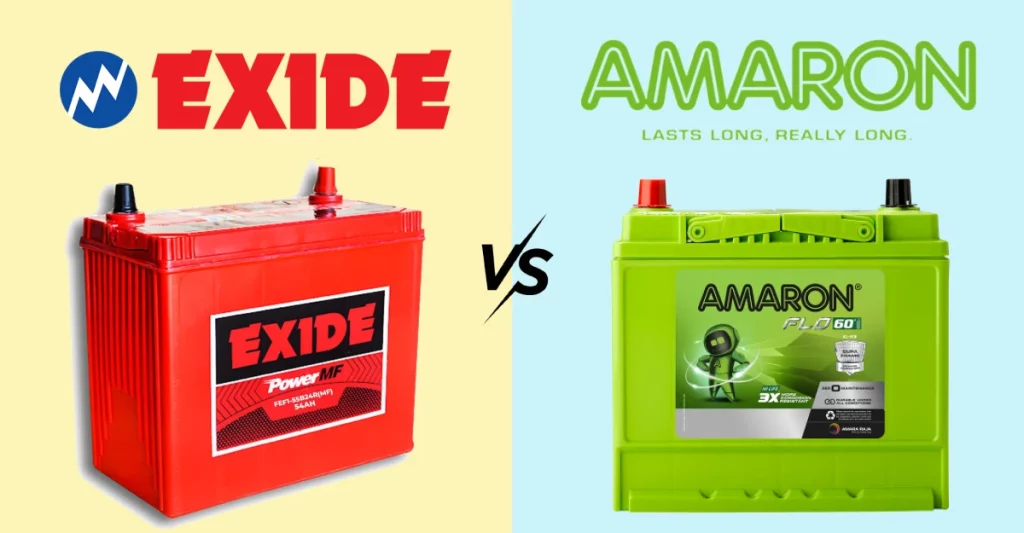As you know, the Indian government is aggressively working on the electrification of India’s vehicle fleet in the coming 6 years. The FAME II and PLI schemes are acting as the cherries on top. These initiatives will be advantageous for many battery manufacturers. However, the two players that will benefit the most from this are- Exide and Amaron.

So, in this article, we will look at the most debated topic- Exide vs Amaron! Which one is leading the battery market? You may ask… Just read on and you’ll get the answer!
(A) Exide vs Amaron: A Brief Overview
First of all, let’s compare the profiles of both the companies-
| Particulars | Exide | Amaron |
| Name of the Company | Exide Industries Limited | Amara Raja Group |
| Type of Company | Public | Public |
| Operating Industry | Battery Manufacturing | Conglomerate (Battery Manufacturing and Electronics) |
| Founded | 1947 | 1985 |
| Headquarters | Exide House, Kolkata, West Bengal, India | Tirupati, Andhra Pradesh, India |
| Area Served | Worldwide | Worldwide |
| Key People | Bharat Dhirajlal Shah(Chairman) Subir Chakraborty(MD & CEO) | Ramachandra Naidu Galla(Founder Chairman) Galla Jayadev(Co-Founder, Chairman & Managing Director) |
| Revenue | Rs.14,592 crore | Rs.12,000 crore |
| Subsidiaries | Chloride Metals Ltd. (CML) Chloride International Ltd. (CIL) Chloride Batteries S.E. Asia Pte Ltd (CBSEA) Espex Batteries Ltd (ESPEX) Associated Battery Manufacturers (CEYLON) LTD. (ABML) Exide Energy Private Ltd. (EEPL) Exide Energy Solutions Ltd. (EESL) | Amara Raja Batteries Ltd Amara Raja Electronics Ltd Amara Raja Power Systems Ltd Amara Raja Infra (P) Ltd Mangal Industries Ltd Amara Raja Media and Entertainment Pvt Ltd |
| Competitors | Livguard, LG Chem, Trojan Battery, Okaya | Ugowork, East Penn Manufacturing Co., Fiamm, Trojan, Okaya |
Note: We have already explained the top 10 manufacturing companies in India. Go through the link for deeper insights.
(B) Exide
Exide Industries Limited (Exide) is a big company in India that makes storage batteries. They’re based in Kolkata and are the biggest maker of lead-acid batteries in India. They have ten factories in India, where they make batteries and home UPS systems. These factories are in places like Maharashtra, West Bengal, Uttarakhand, Tamil Nadu, Haryana, and Gujarat.
Apart from India, Exide also has factories in Sri Lanka, the UK, and Singapore, and they sell their batteries to over 60 countries worldwide. They have a huge network of distributors and dealers, with more than 95,000 of them.
Recently, Exide started making lithium-ion batteries for electric vehicles and other uses under their brand Nexcharge. They’ve also made a new company called Exide Energy Solutions Limited, which will have a factory in Bengaluru, Karnataka, to make even more lithium-ion batteries.
Additionally, through another company they own called Chloride Metals Limited, they recycle lead in three places in India- West Bengal, Maharashtra, and Karnataka.
(C) Amaron
Amara Raja Group, an Indian multinational conglomerate headquartered in Tirupati, boasts a diverse portfolio spanning automotive batteries, packaged foods and beverages, electronics manufacturing, infrastructure, power systems, and sheet metal products and fasteners.
Renowned for its automotive battery brand, Amaron, which holds the position as the second-largest selling automotive battery brand in India, following Exide Industries.
With a workforce exceeding 15,216 employees, Amara Raja Group garnered recognition from Forbes magazine in 2010, earning a spot on Asia’s ‘Best Under A Billion’ list of companies.
(D) Business Comparison of Exide vs Amaron
In this section, we will compare the business aspects of Exide and Amaron. Look at the data given below-
| Business Aspects | Exide | Amaron |
| Market Cap (2024) | Rs.326.53 billion | Rs.159.06 billion |
| Market Share | 50% | 35% |
| Revenue (FY23 INR crore) | Rs.14,592 crore | Rs.12,000 crore |
| Net Sales (FY23 in Rs.million) | 1,50,782 | 1,03,882 |
| EBITDA (INR million) | 15,937 | 13,031 |
| Profit after Tax (INR million) | Rs.8,228 | Rs.6,945 |
| Gross Profit Margin (FY23) | 10.60% | 12.50% |
| Net Profit Margin (FY23) | 5.50% | 6.70% |
From the table comparing Exide and Amaron, several key takeaways emerge. Firstly, in terms of market capitalization (the total value of a company’s outstanding shares), Exide leads with Rs.326.53 billion compared to Amaron’s Rs.159.06 billion, indicating Exide’s larger overall value in the market.
Secondly, Exide holds a larger market share at 50% compared to Amaron’s 35%, suggesting Exide’s dominance in its industry.
Thirdly, Exide outperforms Amaron in terms of revenue, net sales, EBITDA (earnings before interest, taxes, depreciation, and amortization), and profit after tax. This indicates that Exide generates more income and profit from its operations compared to Amaron.
However, despite Exide’s higher revenue and market share, Amaron boasts a higher gross profit margin (12.50% compared to Exide’s 10.60%) and net profit margin (6.70% compared to Exide’s 5.50%), indicating that Amaron is more efficient at generating profits relative to its revenue.
(E) 5-Year CAGR Comparison: Exide vs Amaron
In this section, we will compare the compound annual growth rate (CAGR) of both companies over the last five years. We will mainly focus on three aspects namely- net sales, EBITDA, and PAT.
(E.1) Net Sales CAGR (INR million)
| Years | Exide | Amaron |
| FY19 | 1,47,209 | 67,931 |
| FY20 | 1,44,710 | 68,392 |
| FY21 | 1,03,594 | 71,498 |
| FY22 | 1,27,892 | 86,972 |
| FY23 | 1,50,782 | 1,03,882 |
| 5-Year CAGR | 0.50% | 8.90% |
From the table, we can see that Exide’s net sales have shown a slight increase, with a compound annual growth rate (CAGR) of 0.50%. This indicates a small rise on average each year. On the other hand, Amaron’s net sales have been steadily increasing at a healthy CAGR of 8.90% over the same period.
(E.2) EBITDA CAGR (INR million)
Now let’s look at the CAGR of Earnings before Interest, Taxes, Depreciation, and Amortization of both the companies-
| Years | Exide | Amaron |
| FY19 | 16,380 | 9,505 |
| FY20 | 13,998 | 10,983 |
| FY21 | 13,657 | 11,147 |
| FY22 | 14,024 | 10,224 |
| FY23 | 15,937 | 13,031 |
| 5-Year CAGR | -0.50% | 6.50% |
Over the past five years, Exide’s earnings before interest, taxes, depreciation, and amortization (EBITDA) have shown a slight decrease, with a compound annual growth rate (CAGR) of -0.50%, indicating a small decline on average each year. Meanwhile, Amaron’s EBITDA has been consistently increasing, showing a healthy CAGR of 6.50% over the same period.
(E.3) Profit After Taxes CAGR (INR million)
Here is the CAGR comparison of PAT (profit after taxes)-
| Years | Exide | Amaron |
| FY19 | 8,474 | 4,832 |
| FY20 | 7,625 | 6,608 |
| FY21 | 7,334 | 6,469 |
| FY22 | 6,943 | 5,126 |
| FY23 | 8,228 | 6,945 |
| 5-Year CAGR | -0.60% | 7.50% |
Exide’s revenue has been fluctuating, with a slight decrease, averaging a negative growth rate of 0.60% annually. In contrast, Amaron’s revenue has been steadily increasing, with a decent compound annual growth rate (CAGR) of 7.50% over the same period.
(F) Debt Management
Exide Industries and Amara Raja are companies with no debt. Exide is planning to build a factory for making lithium-ion cells and another one for absorbent glass mat (AGM) batteries, which will cost around Rs.40 billion. On the other hand, Amara Raja is investing Rs.95 billion to set up a massive factory capable of producing 16 gigawatts of lithium-ion batteries, along with an advanced energy research center and two gigawatts of lithium plants using NMC technology.
Despite spending so much money on these plans, both companies have enough cash to comfortably cover the costs. Moreover, they have a high-interest coverage ratio, indicating they have enough money to pay off their interest.
In the fiscal year 2023, Amara Raja’s interest coverage ratio was 43.9x, while Exide Industries’ interest coverage ratio was 15.5x.
(G) Which one is leading the batteries market- Exide or Amaron?
In the batteries market, Exide and Amaron are major players, but Exide currently leads the market. Exide has a larger market capitalization, higher revenue, and a larger market share compared to Amaron. However, Amaron’s revenue and net sales have been consistently growing over the years at a faster rate than Exide’s. Despite this, Exide maintains its lead in the market due to its larger size and market dominance.
Thus, we can say that while Amaron shows promising growth, Exide’s established position gives it an edge in the batteries market. It will be interesting to see how Amaron beats Exide in the coming years!


Never knew that Exide batteries has this much of a larger market share and also is on top in terms of revenue. Thanks for the info!